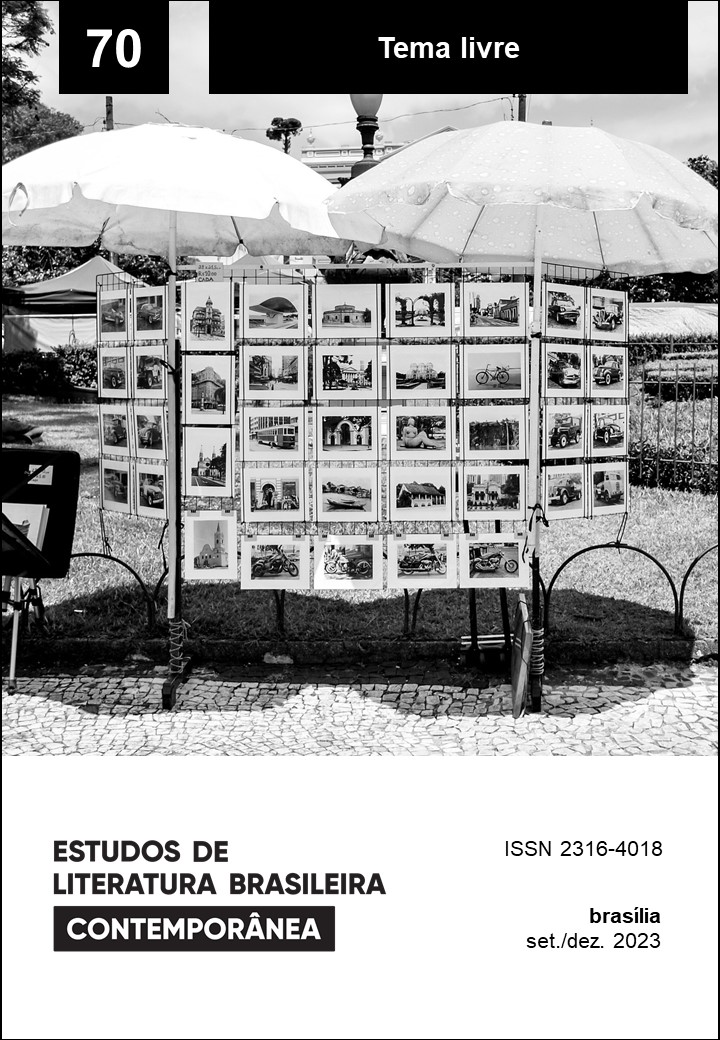Moved like the devil: Juliana Sankofa’s )un(publishable poetry
DOI:
https://doi.org/10.1590/2316-40187012Keywords:
signifying, afro Brazilian poetry, SankofaAbstract
This article introduces a reading of the poetry of the Afro-Brazilian author Juliana Sankofa (2019), whose works do not have access to privileged circles of the mainstream publishers. Focusing on her self-published e-book Comovida como o diabo and applying the concept of “Signifying” developed by Henry Louis Gates Jr. based on Afro-American vernacular practices as the main analytical tool, I demonstrate how such poetry not only dialogues with the issue and situation of Afro-descendants within society and the Brazilian literary canon but also presents specific connections with poetic production in the African diaspora.
Downloads
References
ALVES, Miriam (2019). Aqui o Diabo é Rosa. In: SANKOFA, Juliana. Comovida como o Diabo. Edição da autora. p. 4-5.
ARAÚJO, Carla (2020). Mourão tem dia de Bolsonaro ao negar existência do racismo no Brasil. UOL. Disponível em: https://economia.uol.com.br/colunas/carla-araujo/2020/11/20/mourao-racismo-consciencia-
-negra-bolsonaro-violencia-morte-carrefour.htm?cmpid=copiaecola. Acesso em: 29 ago. 2023.
ASSIS, Joaquim Maria Machado de (1977). Noite de almirante. In: ASSIS, Joaquim Maria Machado de. Histórias sem data. 2. ed. Rio de Janeiro: Civilização Brasileira. p. 170-176.
BÉCQUER, Gustavo Adolfo. “Rimas y leyendas.” Cervantes virtual. Biblioteca Virtual Miguel de Cervantes.
Disponível em: https://www.cervantesvirtual.com/obra-visor/rimas-y-leyendas--0/html/00053dfc-82b2-11df-acc7-002185ce6064_4.html. Acesso em: 29 ago. 2023.
CARDENAL, Ernesto (2019). Poesía completa. Madri: Trotta.
CERVANTES, Miguel de (2009). El ingenioso higaldo Don Quijote de la Mancha. 28. ed. Madri: Cátedra.
CHRISTIAN, Barbara (1987). The race for theory. Cultural Critique, n. 6, p. 51-63. https://doi.
org/10.2307/1354255
DALCASTAGNÈ, Regina (2005). A personagem do romance brasileiro contemporâneo: 1990-2004. Estudos
de Literatura Brasileira Contemporânea, Brasília, n. 26, p. 13-71.
DUARTE, Eduardo de Assis (2009). A capoeira literária de Machado de Assis. Literafro, n. 3.
FELINTO, Marilene (2019). As mulheres de Tijucopapo. 4ª ed. São Paulo: Edição da Autora.
GATES JR., Henry Louis (1988). The Signifying Monkey: A theory of African American literary criticism.
Nova York: Oxford University Press.
GATES JR., Henry Louis (2004). The Blackness of Blackness: A Critique on the Sign and the Signifying Monkey. In: RICKIN, J.; RYAN, M. (org.). Literary Theory: An anthology. 2. ed. Malden: Blackwell Publishing. p.
-1004.
GONZALEZ, Lélia (2020). Por um feminismo afro-latino-americano. Rio de Janeiro: Zahar.
LIMA, Luiz Costa (1997). Machado: mestre de capoeira. Espelho: Revista Machadiana, v. 3. p. 37-43.
MIRANDA, Fernanda R. (2019). Silêncios pRescritos: Estudo de romances de autoras negras brasileiras (1859-
. Rio de Janeiro: Malê.
MITCHELL-KERNER, Claudia (1972). Signifying, Loud-Talking, and Marking. In: KOCHMAN, T. (org.).
Rappin’ and Stylin’ out: Communication in urban Black America. Champanhe: University of Illinois Press.
p. 315-335.
NORDQUIST, Richard (2020). What Signifying means in African American Discourse. ThoughtCo. Disponível em: https://www.thoughtco.com/signifying-definition-1691957. Acesso em: 17 ago. 2023.
SANKOFA, Juliana (2019). Comovida como o diabo. Edição da Autora.
Downloads
Published
How to Cite
Issue
Section
License
Copyright (c) 2024 Paulo Dutra

This work is licensed under a Creative Commons Attribution 4.0 International License.
Authors who publish in this journal agree to the following terms:
a) The authors maintain the copyright and grant the journal the right of first publication, the work being simultaneously licensed under the Creative Commons Attribution License-Non Commercial 4.0 which allows the sharing of the work with acknowledgment of the authorship of the work and publication this journal.
b) Authors are authorized to enter into additional contracts separately, for non-exclusive distribution of the version of the work published in this journal (eg publish in institutional repository or as a book chapter), with authorship recognition and publication in this journal.
c) Authors are allowed and encouraged to publish and distribute their work online (eg in institutional repositories or on their personal page) after the editorial process, as this can generate productive changes, as well as increase the impact and citation of published work (See The Effect of Free Access).
d) The authors of the approved works authorize the magazine to, after publication, transfer its content for reproduction in content crawlers, virtual libraries and the like.
e) The authors assume that the texts submitted to the publication are of their original creation, being fully responsible for their content in the event of possible opposition by third parties.


